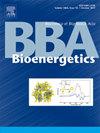人类VDAC3作为细胞内氧化还原状态的传感器:在氧化应激中细胞保护机制的贡献
IF 2.7
2区 生物学
Q2 BIOCHEMISTRY & MOLECULAR BIOLOGY
引用次数: 0
摘要
电压依赖性阴离子通道(vdac)对线粒体功能至关重要,促进细胞质和线粒体之间代谢物的交换。本研究研究了人类VDAC类似物hVDAC1、hVDAC2和hVDAC3在缺乏内源性VDAC(由POR1和POR2编码)和抗氧化酶,即超氧化物歧化酶(由SOD1和SOD2编码)的酿酒酵母菌株氧化应激下维持线粒体功能的作用。表达hVDAC3的酵母细胞在氧化应激下生长稳定,维持线粒体膜电位和形态,超氧阴离子水平降低,质子泄漏最小,ATP合成效率高。相反,表达hVDAC1或hVDAC2的细胞线粒体功能受损,这与生物能量谱的差异(包括ATP合成和质子泄漏)、FCCP解偶联能力和备用呼吸能力的差异有关。hVDAC3的半胱氨酸缺失变体(hVDAC3ΔCys)在应激条件下显示细胞生长受损,表明hVDAC3中的半胱氨酸残基对其保护作用至关重要。这些发现强调了hVDAC3在氧化应激下独特的保护功能,这归因于半胱氨酸氧化对代谢物的有效运输和调节。本文章由计算机程序翻译,如有差异,请以英文原文为准。
Human VDAC3 as a sensor of the intracellular redox state: contribution to cytoprotection mechanisms in oxidative stress
Voltage-dependent anion channels (VDACs) are essential for mitochondrial function, facilitating the exchange of metabolites between the cytosol and mitochondria. This study investigated the role of human VDAC paralogs, hVDAC1, hVDAC2, and hVDAC3, in maintaining mitochondrial function under oxidative stress in Saccharomyces cerevisiae strains lacking endogenous VDACs (encoded by POR1 and POR2) and antioxidant enzymes, i.e., superoxide dismutases (encoded by SOD1 and SOD2). The yeast cells expressing hVDAC3 showed stable growth under oxidative stress, maintained mitochondrial membrane potential and morphology, exhibited reduced superoxide anion levels, and achieved efficient ATP synthesis with minimal proton leak. In contrast, the cells expressing hVDAC1 or hVDAC2 presented impaired mitochondrial function which was supported by differences in bioenergetic profiles including ATP synthesis and proton leak but also FCCP uncoupling capacity and spare respiratory capacity. The cysteine-depleted variant of hVDAC3 (hVDAC3ΔCys) showed impaired cell growth under stress conditions, indicating that the cysteine residues in hVDAC3 are essential for its protective role. These findings highlight the unique protective function of hVDAC3 under oxidative stress, which is attributed to efficient metabolite transport and regulation via cysteine oxidation.
求助全文
通过发布文献求助,成功后即可免费获取论文全文。
去求助
来源期刊

Biochimica et Biophysica Acta-Bioenergetics
生物-生化与分子生物学
CiteScore
9.50
自引率
7.00%
发文量
363
审稿时长
92 days
期刊介绍:
BBA Bioenergetics covers the area of biological membranes involved in energy transfer and conversion. In particular, it focuses on the structures obtained by X-ray crystallography and other approaches, and molecular mechanisms of the components of photosynthesis, mitochondrial and bacterial respiration, oxidative phosphorylation, motility and transport. It spans applications of structural biology, molecular modeling, spectroscopy and biophysics in these systems, through bioenergetic aspects of mitochondrial biology including biomedicine aspects of energy metabolism in mitochondrial disorders, neurodegenerative diseases like Parkinson''s and Alzheimer''s, aging, diabetes and even cancer.
 求助内容:
求助内容: 应助结果提醒方式:
应助结果提醒方式:


